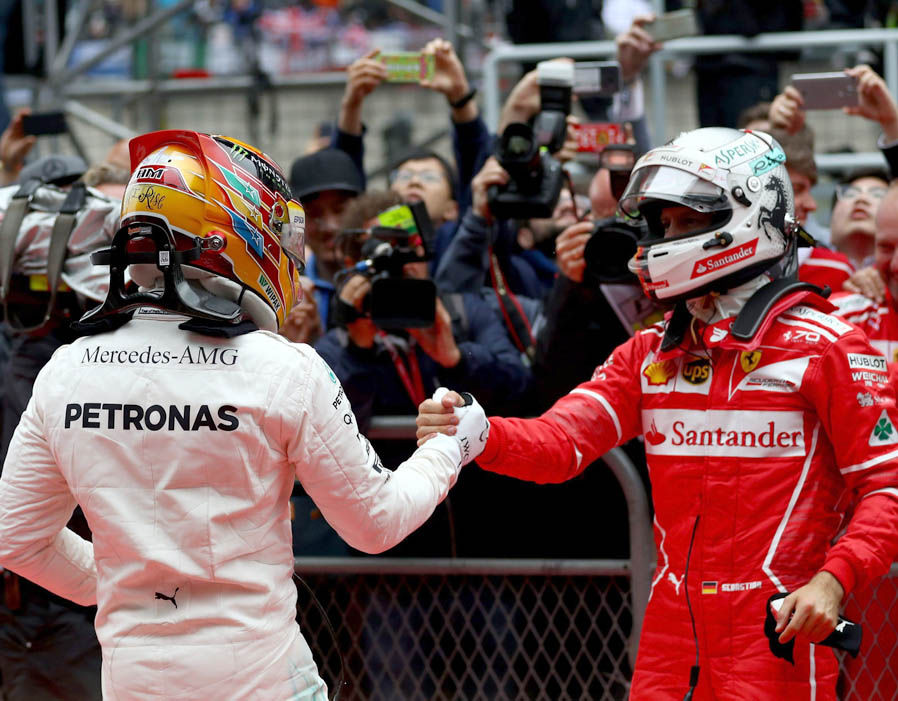Formula 1 returns to its old ways after the 2017 Chinese Grand Prix in Shanghai

By Callum Springall
After an anti-climactic yet equally refreshing opening in Melbourne, Formula 1’s V6 hybrids roared – or farted if you’re a member of the Will Buxton school of thought – into life in China.
Despite a slow start and something to do with a hospital, Saturday gave rise to a fine battle between Sebastian Vettel and the two Mercedes, as Valtteri Bottas missed out on the front row by one thousandth of a second – the equivalent of 5.9cm.
Elsewhere, Max Verstappen had to make do with four cylinders and the 19th fastest lap, ahead only of Esteban Ocon who seems to be making a habit of not getting a lap together in qualifying. Antonio Giovinazzi also managed to find an innovative and rather expensive way of progressing in qualifying.
So it was all set up for a great race. We could all sit back and witness another Verstappen slog through the field for the first 30 laps or so – only for Max to be sixth after a couple of laps. No matter. I’m sure another Vettel-Hamilton duel at the sharp end would keep us entertained – with a helping of an imaginary grid slot to give the Ferrari a wider entry into turn 1.
Giovinazzi had that ‘difficult second album’ kind of weekend and hit the wall for the second time in as many days, bringing out the safety car. Vettel had already pitted and so lost out, ending up sixth. He recovered well: two-stopping and managing to keep the charging Red Bulls behind without any further delays to claim second and prevent Hamilton putting any daylight between him and his nearest rival.
For their team-mates it was a pretty drab afternoon. Kimi Raikkonen managed to contract Hamilton Syndrome – a rare condition in the modern F1 world brought on by ‘excessive tyre wear’. Symptoms include kicking, screaming and a dose of underachievement.
Meanwhile, Bottas got a little over-exuberant under the safety car and after a few seconds plus a pirouette, he was well down the order. At the end he was er… sixth.
Other worthy mentions include Ocon, who started alongside Verstappen and without making it ‘like a video game’ – which is no exaggeration by Max, I’ll tell you that now – managed to take a point for the second time in as many races for Force India.
Mind you, he did say there was a bit more in the tank and I wouldn’t be surprised if he were to fulfill the potential that the Mercedes junior is promising.

It proved an expensive weekend for Sauber thanks to the exploits of Antonio Giovinazzi in Shanghai.
At the centre of much great racing in Shanghai was the effect of the drag reduction system (DRS) – or thankfully, lack thereof – as it seemed the higher levels of drag created by the new regulations also brought with it a ‘brick wall’, as Norfolk’s very own Martin Brundle put it during Sky’s TV coverage.
In the engineering vernacular, I would believe that he means a reduced terminal velocity so that the DRS could take the chasing driver(s) only so far in their top speed – although it did reduce the pain inflicted by the dirty air through the corners and kept the drivers a bit closer together, possibly allowing the kind of moves we saw in the braking zone of turn 6. I’m thinking Vettel’s daring move around the outside of Daniel Ricciardo.
SUBSCRIBE: Listen to The NR F1 Podcast on your chosen podcast player
So DRS might finally be a good thing. Now the cars have more frontal area and more drag, it may mean less potent tow and therefore less straightforward overtaking manoeuvres.
However, I would assume the system could still do with some tinkering. Shorter DRS zones may be the happy medium Liberty Media seek to improve the show, while keeping the purists engaged with organic racing.
One more thing for the purists – and the paying fans – is one small question for the FIA. If practice couldn’t be run for large parts because of the inability of the medical helicopter to land at the designated hospital 40km away,  why has it not been proposed to invest in the infrastructure of the circuits and have the medical centres at the track stocked with the neurological and other such equipment needed in the event of an emergency? That way, it reduces the likelihood of a session being stopped and the fans being sent back to sleep.
why has it not been proposed to invest in the infrastructure of the circuits and have the medical centres at the track stocked with the neurological and other such equipment needed in the event of an emergency? That way, it reduces the likelihood of a session being stopped and the fans being sent back to sleep.
Who knows. Maybe it’s a valid assumption but perhaps there isn’t enough room to expand the medical capabilities of the facilities already at the circuit? Maybe there isn’t the fiscal willpower on Liberty’s part – or that of the circuits – to make it happen. It could be to do with hiring doctors – possibly from the surrounding area, or to assign dedicated doctors to work alongside the official FIA medical coordinator for the year – or it may be the case it simply isn’t a necessary solution, since the specialist equipment was moved to a hospital 5km from the circuit before race day.
Either way, China felt like the race that got the reintroduction of Formula 1 to the world truly under way. And that’s something to celebrate.
♦ Callum Springall is a blogger with the NRF1. You can follow Callum on Twitter @callumspring18

